CHAPTER 3. HEALTH STATUS
INTRODUCTION
Being overweight or obese is a modifiable risk factor for a number of chronic diseases, including National Health Priority Area (NHPA) conditions such as diabetes, cardiovascular disease, osteoarthritis and some cancers. Excess body weight is also associated with a range of risk factors for chronic disease such as high blood pressure and high blood cholesterol (AIHW 2006).
SELF ASSESSED HEALTH STATUS
In the NHS, respondents reported their general assessment of their own health, selecting a single option from a five point scale: excellent, very good, good, fair, poor.
In 2004-05, 20% of adults reported their self assessed health status as excellent, 35% very good, 28% good, 12% fair and 5% poor.
Adults classified as overweight or obese were less likely than those classified as underweight or normal weight to assess their health as excellent or very good (50% compared with 62%). Overweight or obese adults were more likely than those classified as underweight or normal weight to rate their health as fair or poor (19% compared to 13%).
3.1 Self assessed health status(a)
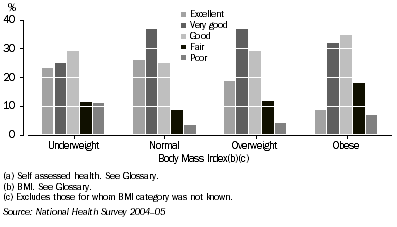
Obese women were equally as likely as obese men to rate their health as excellent (9% and 8% respectively) or very good (33% and 31%).
Underweight men were more likely than underweight women to place their health self-assessment at the extremes of the scale, that is: excellent (29% and 22% respectively) or poor (17% and 10%).
LONG-TERM CONDITIONS
The likelihood of having a long-term condition (one that lasted or was expected to last for six months or more) among adults who were overweight was similar to the general population (around 87%). However, people who were obese were slightly more likely to have a long-term condition.
Proportionally more overweight or obese adults had multiple long-term conditions. Overall, the average number of long-term conditions reported by each adult was 3. Obese adults reported having an average of 4 conditions. Of those with 5 or more long-term conditions, 61% were overweight or obese.
DISEASES OF THE CIRCULATORY SYSTEM
Diseases of the circulatory system are those related to the heart and blood vessels, including heart, stroke and vascular diseases. Overweight and obesity pose a major risk for diseases of the circulatory system (WHO 2003).
In 2004-05, 23% of Australian adults (approximately 3.2 million people) had a disease of the circulatory system. Circulatory system diseases were highest among overweight or obese adults (28%), followed by those classified as underweight or normal weight (18%).
These diseases were slightly more likely to be reported by women (26%) than men (21%) regardless of body mass. The highest proportion was reported among obese women (38%), followed by overweight women (29%), obese men (29%) and overweight men (22%).
3.2 Diseases of the circulatory system
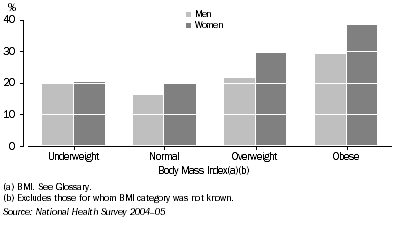
Heart disease
Forms of heart disease include hypertensive disease and ischaemic heart disease (including angina). Being overweight or obese is a major risk factor for heart disease (AIHW 2007).
In 2004-05, 15% of Australian adults (approximately 2.1 million people) had heart disease. Of adults who were overweight or obese, 20% had heart disease. Obese adults were most likely to report heart disease. More than a quarter (26%) of adults who were obese reported heart disease, while 18% of those who were overweight reported heart disease. This rate halved for those with a normal weight (10%) and decreased further in those who were underweight (8%).
Three quarters (75%) of males with heart disease were overweight or obese, whereas two thirds (66%) of females with heart disease were overweight or obese. Although nearly half (46%) of males with heart disease were overweight, the proportion of females with heart disease was evenly spread between the normal (32%), overweight (35%) and obese (31%) categories.
Hypertensive disease
Hypertensive disease or high blood pressure is the most common form of heart disease, and is a risk factor for other more severe diseases of the circulatory system such as coronary heart disease and stroke (AIHW 2007). Overweight and obesity lead to adverse metabolic effects on blood pressure (World Health Organisation 2003).
In 2004-05, 14% of Australian adults (approximately 1.9 million people) had hypertensive disease. The proportion with high blood pressure increased with BMI category. Among those in the underweight category 7% reported elevated blood pressure, followed by adults of normal weight (9%), 16% of those who were overweight and 24% among those classified as obese.
HIGH BLOOD CHOLESTEROL
High blood cholesterol is a risk factor for diseases of the circulatory system such as coronary heart disease and stroke (AIHW 2007a). As for high blood pressure, overweight and obesity lead to adverse metabolic effects on blood cholesterol (WHO 2003).
In 2004-05, 9% of Australian adults (approximately 1.3 million people) had high blood cholesterol. The proportion of people with high cholesterol increased with BMI category, with a marked increase occurring between the normal weight and overweight categories where the proportion doubled. Among those classified as underweight or normal weight 6% reported high blood cholesterol, compared to those classified as overweight or obese (12%) with high cholesterol.
High cholesterol was reported by 9% of both men and women and there was very little difference between the sexes across BMI categories.
3.3 High blood cholesterol
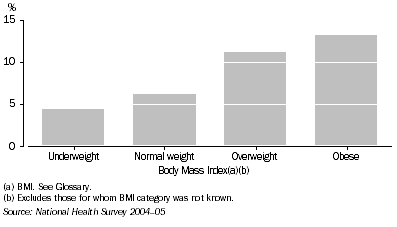
DISEASES OF THE MUSCULOSKELETAL SYSTEM AND CONNECTIVE TISSUE
Diseases of the musculoskeletal system and connective tissue manifest in many forms of joint problems and disorders of the bones and muscles and their attachments, including arthritis, osteoporosis, rheumatism, back pain and disc disorders. Chronic musculoskeletal conditions are among the debilitating health problems associated with obesity (WHO 2003).
In 2004-05, 40% of Australian adults (approximately 5.5 million people) had a disease of the musculoskeletal system. Musculoskeletal diseases were more prevalent among overweight or obese adults (44%), than among those classified as underweight or normal weight (35%).
The proportion of women (42%) with diseases of the musculoskeletal system was higher than the corresponding proportion of men (38%), and this was evident in all BMI categories. More than half (52%) of obese women, and 45% of overweight women had a musculoskeletal disease. In men, 45% of the obese and 40% of the overweight had at least one of these conditions.
3.4 Diseases of the musculoskeletal system
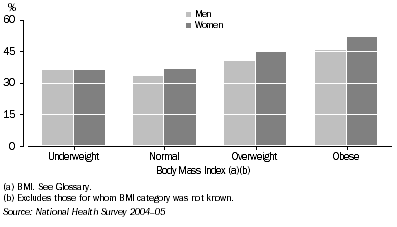
Arthritis
Of those who were overweight or obese, 23% reported arthritis, including osteoarthritis (19% of men and 29% of women). Arthritis is age related, and the proportion of overweight or obese adults with arthritis increased with age with the highest proportion in the 75 years or more age group (54%).
Osteoarthritis
Osteoarthritis is among the most common forms of arthritis. It is a degenerative condition caused mainly by accumulated wear of the cartilage that cushions the ends of bones where they meet to form a joint. As the cartilage degenerates the normal functioning of the joint is disrupted causing pain. The disease affects mainly the hands, spine and weight-bearing joints such as the hips, knees and ankles. Excess body weight is a risk factor for osteoarthritis (AIHW 2007).
In 2004-05, 10% of Australian adults (approximately 1.4 million people) had osteoarthritis. Of adults who reported osteoarthritis, 63% were classified as overweight or obese. The prevalence of this condition was higher for women (13%) than men (8%), and this was the case in all except the underweight BMI category. Of women classified as overweight or obese, 17% reported osteoarthritis compared to 9% of those women classified as underweight or normal weight. In contrast, for overweight or obese men, 9% reported osteoarthritis compared to 7% of underweight or normal weight men.
DISEASES OF THE RESPIRATORY SYSTEM
The debilitating health problems associated with obesity include respiratory difficulties (WHO 2003), such as chronic obstructive pulmonary disease, asthma, obstructive sleep apnea and obesity hyperventilation syndrome.
In 2004-05, nearly a third (32%) of Australian adults (approximately 4.4 million people) had a respiratory condition. Diseases of the respiratory system were more prevalent in women (35%) than in men (28%), and this was the case in each BMI category. Respiratory conditions were most prevalent among obese women (43%).
DIABETES
Type 2 diabetes is characterised by resistance in the body's ability to use insulin and is likely to develop after 40 years of age. It is also known as non-insulin dependent diabetes mellitus. Overweight and obesity lead to adverse metabolic effects, including insulin resistance which is associated with type 2 diabetes (WHO 2003).
Of adults with Type 2 diabetes, 75% were overweight or obese. As BMI category increased, so did the prevalence of Type 2 diabetes, particularly for obese adults. The reported prevalence of Type 2 diabetes among overweight adults (3.8%) was almost twice that in normal weight adults (2.2%), and in obese adults the proportion of Type 2 diabetes (9.0%) was more than four times that in normal weight adults.
3.5 DIABETES(a)
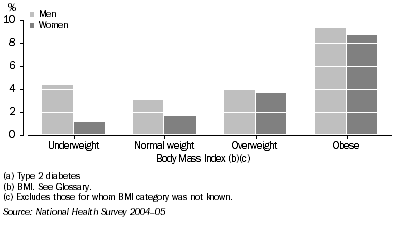
For both men and women, and in most age groups, the proportion with Type 2 diabetes was higher among those who were overweight or obese than it was in those who were underweight or normal weight. This difference according to BMI category was particularly marked for women.
3.6 DIABETES(a), Men
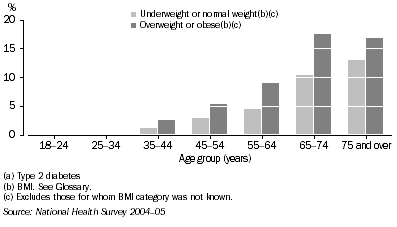 3.7 DIABETES(a),
3.7 DIABETES(a), Women
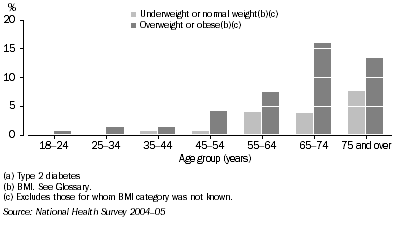
MENTAL OR BEHAVIOURAL PROBLEMS
In 2004-05, 12% of Australian adults (approximately 1.6 million people) reported that they had a mental or behavioural problem. A higher proportion of women (13%) reported having mental or behavioural problems than men (10%) and this was the case in each BMI category. Of those classified as overweight or obese, 12% of men and 16% of women reported a mental or behavioural problem.
Mental or behavioural problems were most common among adults at both ends of the BMI scale. Adults classified as obese or underweight were most likely to report a mental or behavioural problem (14% of obese and 19% of underweight) compared to 11% of both overweight and normal weight adults.
The highest proportion of obese men who reported mental or behavioural problems was in the 25 to 34 and 45 to 54 year age groups (14%). The highest proportion of obese women who reported mental or behavioural problems was in the 35 to 44 year age group (22%).
PSYCHOLOGICAL DISTRESS
In the NHS, to complement data on long term conditions, additional information was collected from adult respondents using the Kessler 10 Scale (K10), a 10 item scale of current psychological distress. The K10 asks about negative emotional states in the four weeks prior to interview. The results from the K10 are grouped into four categories: low (indicating little or no psychological distress); moderate; high; and very high levels of psychological distress. Based on research from other population studies, a very high level of psychological distress (as shown by the K10) may indicate a need for professional help.
In 2004-05, almost two thirds (63%) of adults were classified as having low levels of psychological distress, nearly a quarter (24%) to moderate levels, 9% to high levels and 4% to very high levels.
Both high and very high levels of psychological distress were more common among adults who were either underweight or obese. Among the underweight, 13% had high levels and 10% had very high levels of psychological distress. In obese adults the corresponding percentages were 11% and 5%.
High or very high levels of psychological distress were most likely to be experienced by underweight women (23%), underweight men (20%) and by obese women (20%).
3.8 HIGH OR VERY HIGH LEVELS OF PSYCHOLOGICAL DISTRESS(a)
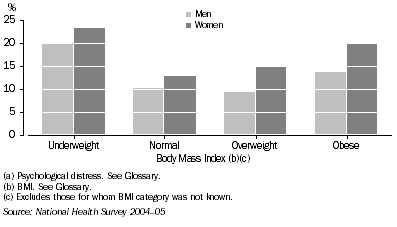
Among adults with a very high level of psychological distress, the extremes of the BMI scale were over-represented. A higher proportion of adults with a very high level of psychological distress were obese (24%) or underweight (7%), compared with adults in the total Australian population (where 18% were obese and 3% were underweight).
INJURIES
Of people classified as overweight or obese, 16% reported experiencing one or more injuries in the four weeks prior to interview, proportionally less than people who were classified as underweight or normal weight (18%). However, of those classified as overweight or obese who had experienced an injury, 26% reported cutting down on their usual activities because of the injury (or most recent if more than one), compared to 21% of those classified as underweight or normal weight who had an injury.
Adults classified as overweight or obese who experienced an injury were less likely than other people to have been injured during sport or leisure activities. Around one quarter (25%) of overweight or obese people were participating in sport or other leisure activities when they had their most recent injury, while almost one third (30%) of adults who were underweight or normal weight were participating in such activities when their injury occurred.
 Print Page
Print Page
 Print All
Print All
 Quality Declaration
Quality Declaration